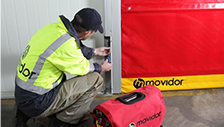Warehouse Managers Improve Site Reliability in 6 Ways
The cooler winter months is a good time for reflection, scheduling in improvement and repairs before Spring / Summer. As we enter spring and summer we can lose track of how badly we need to repair or replace certain elements around the workplace. While you are going through your books, take the time to improve warehouse reliability before Spring.

While the middle of the year can certainly be a quieter time for many industries, it’s also one that requires some important measures to be taken by facility managers who want to keep their operation running as reliably as they can, especially for the busier periods ahead. As the warehouse manager - you know that you simply will not have the time to spare later on. Preparations during the quieter times equals less unnecessary running around during the busy times.
With that in mind, here are the six important notes to keep in mind for warehouse reliability before spring.
1: Review Your Warehouse Maintenance and Operational Plans
Almost every warehouse or manufacturing facility has a plan in place that governs how their employees should use the equipment and tools within the facility. What separates the best warehouses from the mediocre ones, however, is the quality of their maintenance and operating plans.
You must be sure that the policies you have in place make sense based on your employees, the equipment you use, and your operation’s overall goal. Ask yourself a few important questions during your review of warehouse maintenance plans:
- Is the language used in this policy easy to understand by everyone at the organisation?
- Does the policy cover all of the areas it needs to govern?
- Is the policy updated to incorporate new machinery or equipment in your warehouse?
- When was the last time this policy was updated?
A big part of reliability involves having the right guidelines and regulations set in place that are both logical and easy to grasp. This is especially the case during the busy times, when you may be working increased hours and or under increased pressure. Planning ahead for the busy times by adjusting your policies to make them more effective and easier to absorb is an important part of improving your warehouse reliability.
2: Plan for increased staffing needs
How many shifts do you plan to run during a peak season? How many temporary workers will you hire, and what sort of tasks will you allow them to handle? It’s best to answer staffing questions early. If you aim to keep your workers happy, you should also think about some sort of incentive plan that pays bonuses for workers who thrive under pressure / during very active times.
3: Hold Thorough Inspections
Depending on your industry; the End of the Financial Year can be a good time for inspections. If production is usually a little slower during the end of the financial year, this means you may have the time to devote to checking out your machines, conveyor belts, storage racks, warehouse security, doors, guard rails etc.

As the facility manager, this is the perfect time to think about MBWA (Management By Walking Around); yes - this is a famously codified in the seminal business book by Tom Peters and Bob Waterman, “In Search of Excellence: Lessons from America’s Best-Run Companies”, 1982. But the concept is nothing new to business. Check on what’s going on.
Check on what’s going on not only when you’re expected, but sometimes more importantly, when you’re not expected: Management by Walking (or Wandering) Around. Also, ask your team for their feedback on how a process can be done more efficiently.
In other words, keep an eye on things.
While a thorough inspection might not be the most enjoyable activity at your warehouse or facility or make you feel that it is time well spent, it still makes sense to hold at least annual inspections, since it allows you to enter into the New Financial Year knowing that your facility’s equipment is in proper order and can work the way you need it to. Not to mention reduced possibly downtime due to poorly maintained equipment, or worse - injury to a member of staff.
Consider what the cost of not properly inspecting your facility would be if an important device or machinery fails to operate properly and leads to an accident. Did you know that work-related illnesses and injuries cost the economy over $60 billion every year?
Schedule a regular inspections to keep your employees, and your products, safe and prevent your operation from becoming a statistic.
4: Use Quality Components and Parts
Every warehouse or facility manager has felt the temptation to skimp on warehouse equipment, with the hope of saving a few dollars to repair or install new machinery.
Unfortunately, in the long run, this is a decision that can cost you much more than the price difference between a top-quality component and an inferior one. Imagine what would happen if an important element of your warehouse facility were to unexpectedly break as a result of the use of a poor quality part? Or worse still, if you damaged other equipment because your inferior part burst into flames / shattered and now you have an even bigger problem on your hands? 
We’ve previously discussed the benefits of buying Australian made products, which are usually better quality than those produced abroad in countries with less resources and reduced manufacturing regulations.
Another element to mention is that cheaper parts and equipment are often sourced overseas which means that if you need to order a replacement, it can take some time to be delivered. This is not a good thing if you are in the middle of a busy production period with tight deadlines. Whereas local suppliers will be able to supply a spare part quicker and often will have a team available to replace and install new parts for you, meaning that it will be done to a good Australian standard and you save time and money in production down time (not to mention the added stress).
5: Find the Right Warehouse Services Team
If you discover during your inspections, that you have a need for any type of service to your facility or its equipment, it is paramount that you use a reliable organisation that you can trust with your service needs.
 Be sure to take your time and do as much research as possible about their service quality and reputation: if you can, talk to others who have a history of working with them and see what their insights are about the quality of their services.
Be sure to take your time and do as much research as possible about their service quality and reputation: if you can, talk to others who have a history of working with them and see what their insights are about the quality of their services.
By making the decision to go with a cheaper or less-experienced warehouse services company, you are gambling with the safety and efficient production of your facility.
Why take a chance with critical areas of your business, when you could call on a reliable service team that can get the job done right the first time.
6. LOGISTICS Deadlines & Communication
Have you promised goods to your customers and then had to disappoint them with the news that their products are going to be late?
Moving your deadlines a day or two later is likely to reduce much of your last-minute stress and set more realistic fulfilment expectations with consumers.
Again, successful logistics execution requires a lot of planning; giving yourself contingency time built into expectations and you’ll be giving the customer realistic estimates for delivery. Make sure you have tools in your system that allows for tracking and gives notifications of the delivery process along the way. Not only will this save time checking in on delivery drivers / but allowing the customer to track the delivery themselves – reducing time required at headquarters to respond to customer delivery enquiries. Remember, communication is key! Even if the order is running late, the customer is more likely to be understanding if you call in advance, apologize and just let them know when to expect the goods.
Not communicating with the customer will only make them more unhappy - firstly for the late delivery and secondly for the lack of communication. Always make a point of contacting the customer as soon as deadlines change; even if they are unhappy about it - they will appreciate your honesty.
CONCLUSION:
No matter how much you prepare, the busy season can put strain on any business. The business landscape is competitive, and consumers have proven willing to share their displeasure with late or incorrect orders on social media and by other means of word of mouth. Companies that are prepared and execute their services well, will instantly have a competitive advantage.
Planning for the surge with a focus on servicing and maintenance will also keep the CFO and accounting folks happy, as the costs will be accounted for, ahead of time, rather than urgently - during a busy time.
Distribution center mistakes can be mitigated by following the simple steps above, which will help create a more cheerful—and profitable—holiday logistics season for all.
If you are looking to improve your warehouse reliability this year, schedule a service with Remax Doors (Click here)or check out our guide to choosing warehouse roller doors. Our resources will help you ensure that your organisation has a safe, enjoyable holiday that does not set you back when you resume your normal operation.




